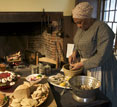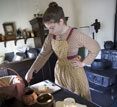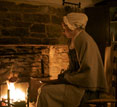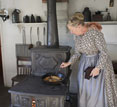Local Roots Blues, Brews & Evening Dining BBQAugust 8, 2014 (6:30pm-9pm, Dinner 7pm) in Greenfield Village PavilionThis is an extraordinary backyard-style event. |
We don’t just grow food – we cook it, too. Using period recipes and ingredients, our costumed presenters employ historically appropriate kitchen utensils and cooking appliances to prepare dishes the residents of these historic homes might have dined on.
 Firestone Farmhouse - c. 1885 Eastern Ohio, Pennsylvania-German influence.
Working with a late 1870s coal stove, we cook and bake employing recipes that are generally Midwestern, but with some Pennsylvania-German influences, as well. Depending on the time of year, you may also see glass-jar canning, pickle-brining, pork butchering and sausage making.  Daggett Farmhouse - mid-18th Century New England Middling (middle class) based.
Most of what we do in this modest home is hearth-cooking and baking based on a variety of early English and American cookbooks. Other food-related activities are stone beehive oven-baking, and various 18th-Century preservation techniques, including pickling and drying, as well as meat curing and smoking. Daggett is also the home of an 18th-Century kitchen garden, including culinary herbs.  Susquehanna Plantation - c. 1860, based on a plantation/
slave household in the Middle Atlantic.
Regular demonstrations of open hearth cooking and baking, focusing on regional dishes with African-American influences.  Edison Homestead - c. 1915, Midwest
Most of what you’ll see here is coal stove cooking and baking. Predictably, though, there is evidence of the impact of changing technology, including precise measurement of ingredients and recipes featuring processed foods. This kitchen uses a c. 1910 icebox, which employs blocks of ice to drive the cooling. The ice is delivered daily. Seasonal foodways are also presented for Easter, Fourth of July, Halloween and Christmas.  Adams Home - 1870, small-town Midwest setting
The centerpiece of this kitchen is a very rare wood-burning step stove from the late 1860s. The recipes at the Adams home focus on church and community cookbooks of the 1870s, 1880s and 1890s.  Mattox Home - c. 1930, rural Georgia, African-American family foodways
Nearly all of the food preparation in this modest sharecropper’s home is done with a small woodstove. Recipes are based on oral traditions of the Mattox family and local/regional foodways and cookbooks.  McGuffey Birthplace - c. 1800 Pennsylvania frontier, Scotch-Irish foodways
Open-hearth cooking and baking demonstrations here are built around recipes based on regional and Scotch-Irish influenced foodways.  Henry Ford Birthplace - 1876, Midwest farmhouse
The food programs here go well beyond the regional rural dishes we prepare on and in the wood-burning stove. You’ll also find canning demonstrations using glass jars to preserve pickles, relish and preserve recipes of the period. 
Cooking with The Henry Ford: Toad in the Hole
Try this easy traditional English dish for your next breakfast. Learn the authentic way to make this family favorite straight from the historic kitchen of the Edison Homestead. Visit in person for live culinary demonstrations daily throughout our many historic homes and farms in Greenfield Village. Each season brings new surprises and inspiration to your table. |